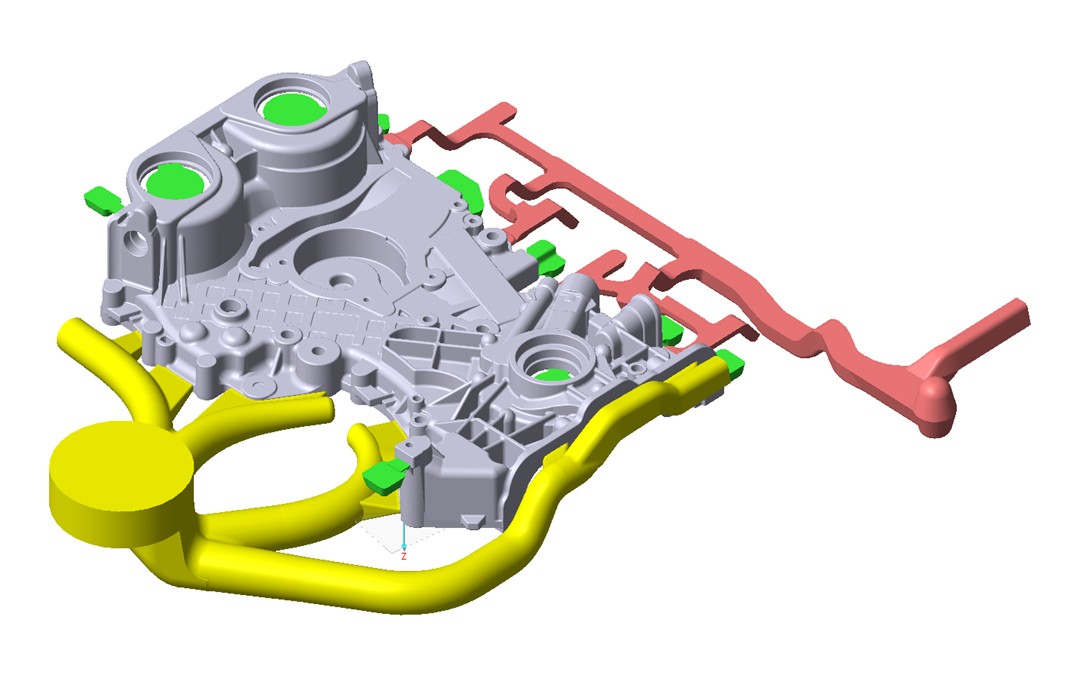In this post we are going to analyse the functions of CastleMIND, the software that allows for the optimisation of high pressure die casting (HPDC) mould design and mould manufacturing.
CastleMIND: the module dedicated to mould optimisation
CastleMIND is the first step in the Castle software workflow: it is a simulation software that allows optimising a project from the first stages, thanks to the definition of some fundamental parameters, e.g. the casting gating section, the machine to be used and other important process parameters.
These kinds of analyses, which are often usually done inside the company by skilled and experienced people, are derived from knowledge that is hard to transmit and standardise. CastleMIND operates with a constantly updated calculation engine based on data collected in more than twenty years of foundry experience. This software allows the designer to carry out these evaluations during the first stages of mould design to define, from scratch, a sketch of the fundamental configuration of the die casting mould.
Practical experience and foundry knowledge have guided PiQ2 in the creation of a versatile product, which can offer substantial help to designers and operators, providing them with a bunch of functions that are useful along the whole design workflow.
CastleMIND allows its users to:
– Evaluate the global settings well before mould design
– Accurately predict the actual performance of the mould on the desired machine
– Define the qualitative specifications targets
– Optimise the mould-machine system
– Understand how to manage during the production stage to reduce potential defects or mould wear.
Let us now examine in detail these functions and the technical solutions used by PiQ2 in the development of the software.
Evaluation of the overall die configuration
In the post Simulation Software for Die Casting: Castle by PiQ2 we have seen how the specialisation on the die casting process allows Castle to offer the user a simple and intuitive interface based on a few and self-explaining technology-specific settings.
The input to be entered in the software interface is entirely derived from the data given by the user concerning the geometry of the component, the raw material and the equipment to be used, together with the defined qualitative requirements.
Regarding the geometry of the component, CastleMIND allows for an evaluation and analysis of thicknesses, cross-sections and dimensions thanks to the Integrated CAD software. The CAD software makes it possible to create and modify the project in-house and thus analyse different scenarios.
CastleMIND relies on a calculation engine which is different for cold and hot chamber technologies. In both cases, the database of materials contains all the data necessary for the die casting process optimisation and mould manufacturing. The use of this specific materials database brings the advantage of considering all process aspects connected to the raw material, as well as reducing the potential human error in data entry.
Prediction of the actual performance of a mould on a machine and definition of the qualitative targets
For the prediction of the performance of a mould on a press, CastleMIND relies on a constantly updated and customizable database containing equipment from most of the main manufacturers on the market. Each press is characterised by its hydraulic features, its performance and – in the case of customised profiles – by the machine’s maintenance status too.
The possibility to customize the database with the characteristics and peculiarities of each machine allows the designer to quickly evaluate different production scenarios and to obtain extremely reliable and effective simulation results.
In addition to that, it is possible to define the qualitative requirements of the casting to be produced, specifying the expected surface quality and an acceptable porosity level. In this way, it is possible to tailor the project and the production process based on the client’s specific requirements. This allows differentiating products with aesthetic requirements from those with technical or safety specifications since the very first stages.
Optimisation of the mould-machine system
After inserting the data and the desired parameters, in just a few seconds CastleMIND provides an output that allows optimising the mould-machine system. The results of the analysis are then presented in human language through an interface organised in two regions.
The right zone shows the form for the numerical input that can be entered by the user, while the lower part displays the optimised process parameters calculated by the system and a dialogue showing the optimisation hints sentences with hypertext links.
Just by clicking on a button, it is possible to access the PQ2 diagram of the mould/machine system, which is the graph that displays the pressure acting on metal as a function of the alloy flow rate – a fundamental tool for die casting mould designers.
It’s not a coincidence that the PQ2 diagram name inspired the brand of the company that developed the Castle software. PiQ2 has not only borrowed the name from the diagram, but it has also improved its background theory and the visualisation inside the user interface of CastleMIND to make it a useful and manageable tool for mould designing and optimisation. Inside the PQ2 diagram offered by CastleMIND, a yellow rectangle is displayed. Based on the information given by the expert system, it defines the area in which the optimal parameters for the process can be achieved.
Thanks to the simple and intuitive panel view and the improved version of the PiQ2 diagram, CastleMIND allows the user to easily evaluate the different possible production scenarios and observe the influence that every single process parameter change acts on the overall balance of the die.
Production optimisation and mould wear prevention
The knowledge of the foundry has guided PiQ2 in the realisation of software that is useful to the mould designer as well as to the press operator. The result of the analysis performed during mould design is reported into a document that is a real instruction manual to be used by the operator to set the machine parameters or to investigate potential defects during production.
As a matter of fact, this document can also be used as a starting point to identify the cause of the defects and therefore prevent the wearing of the mould through selected actions.
The document contains all the parameters that should be respected in production to obtain an optimised process and products in compliance with the customer’s specifications.
Conclusion: die casting mould design
CastleMIND represents a versatile software that can be used by various people that take part in the die casting production processes such as designers, foundry operators and the sales department. The production can use CastleMIND to sketch a mould design, accurately dimension gatings, runners and venting using extremely fast simulations that consider all of the variables affecting the process. Foundry operators can use CastleMIND to set the main parameters of the die casting process, monitor it over time and optimise it along the way. Sales and project managers can use CastleMIND during the elaboration of a quotation to match with the customer on the obtainable quality requirements and the technical key points of the project. Thanks to the specialisation of Castle in the high pressure die casting process and the very high detail of the analysis carried out by the software, it is therefore relatively simple to intercept setup errors and improve mould reliability from the first design stages.
To learn more about the Castle suite modules please consider reading our post Simulation Software for Die-Casting: Castle from PiQ2. For any questions, do not hesitate to contact us through the following form.

